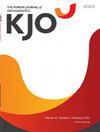From eminence to evidence and back to presence: lessons learned from the evolution of scientific information dissemination and the case of KJO
IF 1.9
3区 医学
Q1 Dentistry
引用次数: 0
Abstract
The last 2 decades have witnessed an array of unprecedented developments in the publishing and managing scientific information and concomitantly to the oral health care practices. From the well-established model of evidence-based principles, which replaced the largely anecdotal evidence or simplified research approaches seen in our field in the 1970’s and 1980’s, we have gone into an era where the focus has been switched from evidence to highlighted and constant presence. The objective is now the bombardment of the practicing health care provider with information from many resources to maintain a constant interest: advertisement to lay persons to build a pressure for the use of specific appliances; organization of corporate symposia and pseudoscientific periodicals run by the industry; abundance of cases, materials, demonstration videos and statements on social media; paid speakers in symposia; key opinion specialists; the list in long... Despite its marketing and corporate advantages and profits, this practice may have unfavorable consequences for the outcome of treatment provided to patients, since it is based on the number and frequency of the repetition of a scientific information as opposed to quality reviewing. Unfortunately, democratization of the scientific information dissemination is not always valid and may have unpredictable sequalae. The ancient Greek proverb oὐκ ἐν τῷ πολλῷ τὸ εὖ (the good is not in the quantity) finds a suitable application in cases where everybody uses a therapeutic mode, appliance, device or method just because it has been applied in huge numbers, many people use it, and it seems logical; all these in the absence of evidence or even worse, in the presence of evidence questioning its efficiency. In the era of delirious pace of information generation from various resources and the social media, the clinician should rely on valid, independent and unbiased resource of evidence, which has been reviewed by journals, which adhere to excellent practices in handling scientific information. The Korean Journal of Orthodontics is a world renown periodical, hosting high quality articles adhering to excellence practices in dissemination of scientific information, and has achieved impressive ratings and impact factor already years ago. With an international outreach including the addition of Associate editors from 7 countries on 4 continents, its improved manuscript handling times, new features such as invited narrative reviews from experts, the KJO would pave the way for a stellar transformation of its profile. It is my intention to build on the long tradition and efforts of the previous Editor Prof. Hyoung-Seon Baik and associate editors who have brought a journal from its conception to a leading status in the field. The prespISSN 2234-7518 eISSN 2005-372X从卓越到证据,再回到存在:从科学信息传播的演变和KJO的案例中吸取的教训
在过去的二十年中,在出版和管理科学信息以及伴随口腔保健实践方面出现了一系列前所未有的发展。在20世纪70年代和80年代,以证据为基础的原则模式取代了我们领域中大量的轶事证据或简化的研究方法,我们已经进入了一个重点从证据转向强调和持续存在的时代。现在的目标是用来自许多资源的信息轰炸执业卫生保健提供者,以保持持续的兴趣:向非专业人员做广告,以建立使用特定器具的压力;组织企业专题讨论会和行业主办的伪科学期刊;社交媒体上有丰富的案例、资料、演示视频和声明;专题讨论会的付费演讲者;关键意见专家;这个名单很长……尽管它具有市场和企业优势和利润,但这种做法可能对提供给患者的治疗结果产生不利影响,因为它是基于重复科学信息的次数和频率,而不是质量审查。不幸的是,科学信息传播的民主化并不总是有效的,并可能产生不可预测的后果。古希腊谚语o υ κ ν τ ολλ ο τ ο(善不在量)在这样的情况下找到了一个合适的应用:每个人都使用一种治疗模式、器具、装置或方法,只是因为它被大量应用,很多人使用,这似乎是合乎逻辑的;所有这些都是在缺乏证据的情况下,甚至更糟的是,在存在质疑其效率的证据的情况下。在各种资源和社交媒体产生信息的疯狂时代,临床医生应该依靠有效的、独立的、公正的证据资源,这些证据资源经过期刊的评审,这些期刊在处理科学信息方面坚持优秀的做法。《韩国正畸杂志》是世界知名的期刊,在科学信息传播方面坚持卓越的实践,刊登高质量的文章,多年前就取得了令人印象深刻的收视率和影响因子。随着国际范围的扩大,包括来自四大洲7个国家的副编辑的加入,其手稿处理时间的改进,以及邀请专家叙述评论等新功能,KJO将为其形象的重大转变铺平道路。我打算继承前任编辑白亨善教授和副编辑们的悠久传统和努力,他们把期刊从构想发展到领域的领先地位。pressissn 2234-7518 eISSN 2005-372X
本文章由计算机程序翻译,如有差异,请以英文原文为准。
求助全文
约1分钟内获得全文
求助全文
来源期刊

Korean Journal of Orthodontics
Dentistry-Orthodontics
CiteScore
2.60
自引率
10.50%
发文量
48
审稿时长
3 months
期刊介绍:
The Korean Journal of Orthodontics (KJO) is an international, open access, peer reviewed journal published in January, March, May, July, September, and November each year. It was first launched in 1970 and, as the official scientific publication of Korean Association of Orthodontists, KJO aims to publish high quality clinical and scientific original research papers in all areas related to orthodontics and dentofacial orthopedics. Specifically, its interest focuses on evidence-based investigations of contemporary diagnostic procedures and treatment techniques, expanding to significant clinical reports of diverse treatment approaches.
The scope of KJO covers all areas of orthodontics and dentofacial orthopedics including successful diagnostic procedures and treatment planning, growth and development of the face and its clinical implications, appliance designs, biomechanics, TMJ disorders and adult treatment. Specifically, its latest interest focuses on skeletal anchorage devices, orthodontic appliance and biomaterials, 3 dimensional imaging techniques utilized for dentofacial diagnosis and treatment planning, and orthognathic surgery to correct skeletal disharmony in association of orthodontic treatment.
 求助内容:
求助内容: 应助结果提醒方式:
应助结果提醒方式:


